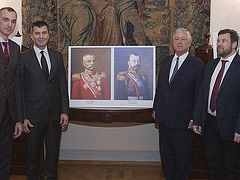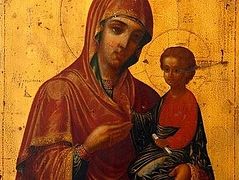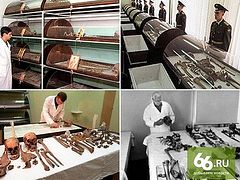Source: Christie's
November 4, 2016
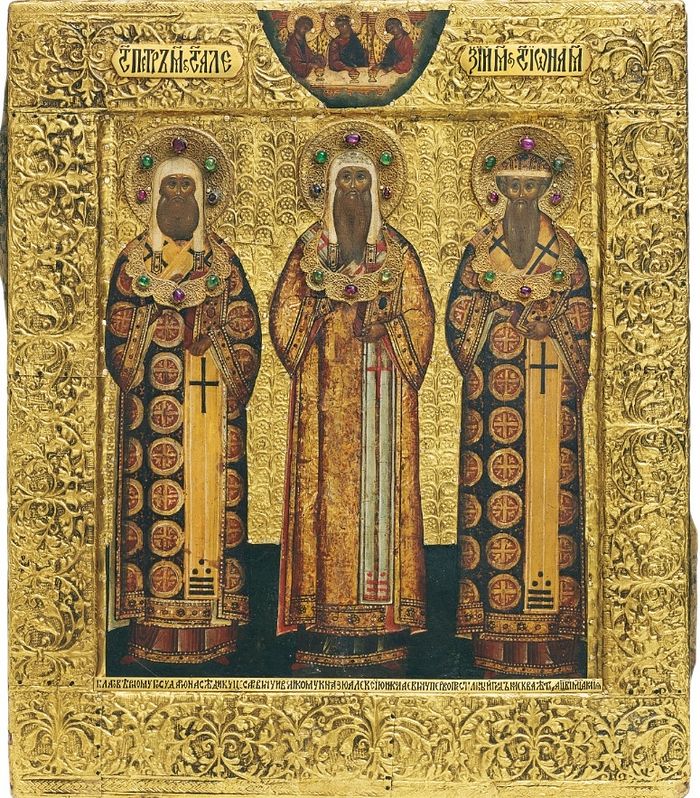 A highly important jewelled gold-mounted presentation icon of the patron saints of Moscow: Alexis, Peter and Jonah. The icon, Moscow, third quarter 17th century; the oklad, assembled circa 1912. 12½ x 10¾ in (31.8 x 27.5 cm). Estimate: £80,000-120,000. This lot is offered in Russian Art on 28 November 2016 at Christie’s in London, King Street
A highly important jewelled gold-mounted presentation icon of the patron saints of Moscow: Alexis, Peter and Jonah. The icon, Moscow, third quarter 17th century; the oklad, assembled circa 1912. 12½ x 10¾ in (31.8 x 27.5 cm). Estimate: £80,000-120,000. This lot is offered in Russian Art on 28 November 2016 at Christie’s in London, King Street When Christie’s Russian Art specialists were presented with this extremely rare icon, it was clear that they had come across a very special and historically significant object. But if they knew the broad outlines, much of the piece’s significance was unknown. This sparked a four-month investigation by the Russian Art department, leading from London’s King Street to historical archives in Moscow.
The 17th-century icon once belonged to Tsesarevich Aleksei (1904–1918), the only son of Emperor Nicholas II and Empress Alexandra Feodorovna and the last heir to the Imperial Russian throne. Decorated with a gold mount (oklad) assembled from earlier embossed pieces, as well as contemporary filigree jewelled mounts, it depicts St. Alexis, Metropolitan of Moscow (the spiritual head of the Russian Orthodox Church), who was also the patron saint of Tsesarevitch Aleksei. With its resemblance to early medieval assembled examples, the icon embodies the revival of a traditional Russian artistic vernacular.
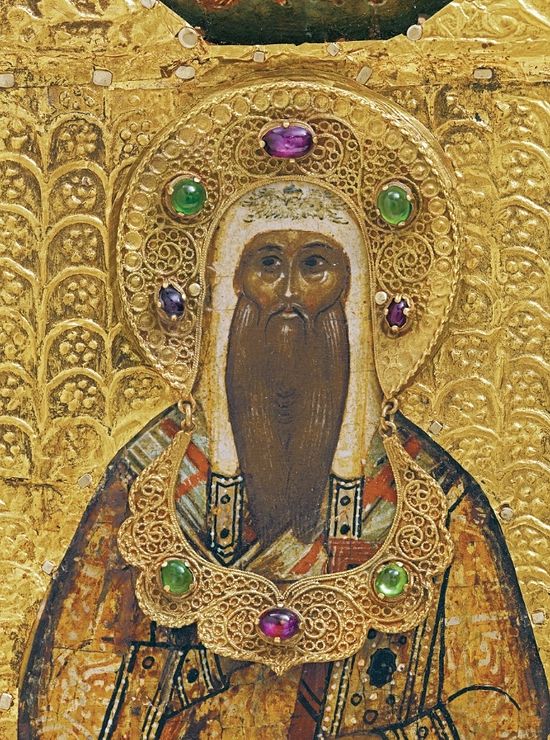 A highly important jewelled gold-mounted presentation icon of the patron saints of Moscow: Alexis, Peter and Jonah (detail). The icon, Moscow, third quarter 17th century; the oklad, assembled circa 1912. 12½ x 10¾ in (31.8 x 27.5 cm). Estimate: £80,000-120,000. This lot is offered in Russian Art on 28 November 2016 at Christie’s in London, King Street
A highly important jewelled gold-mounted presentation icon of the patron saints of Moscow: Alexis, Peter and Jonah (detail). The icon, Moscow, third quarter 17th century; the oklad, assembled circa 1912. 12½ x 10¾ in (31.8 x 27.5 cm). Estimate: £80,000-120,000. This lot is offered in Russian Art on 28 November 2016 at Christie’s in London, King Street Tsesarevitch Aleksei died in 1918 — aged just 13 — following the Bolsheviks’ passage of a death sentence on the Romanov family. ‘Objects belonging to the Tsesarevitch, who was canonised as a Holy Martyr in 2000, very rarely appear on the market’, explains Margo Oganesian, Associate Russian specialist at Christie’s. ‘We knew that we had an incredibly interesting and rare piece’. It was always believed that the icon had been presented to Tsesarevich Aleksei in 1912 by the Moscow Nobility Society, and so the research began.
Examining the icon, they noted a plaque inscribed in old Slavonic, ‘Pious Heir to the Throne Tsesarevitch and Grand Prince Alexei Nikolaevich, Moscow City, 1912 May’. It was known that in May 1912 Tsesarevich Aleksei travelled to Moscow with his parents for the unveiling of a statue of his grandfather, Alexander III. It was his first state visit to Moscow, and the occasion was celebrated with festivities and receptions.
‘We knew that gifts to the Imperial family were noted in the Imperial Cabinet archives, so our researcher in Russia began to examine the records from the Moscow Nobility Society,’ explains Oganesian. The Moscow Nobility Society archives did indeed include a detailed account of the icon it presented to Tsesarevitch Aleksei. But upon examination, it became clear that that icon was not one of St. Alexis but of Vladimir Mother of God, painted by the renowned early 20th-century Russian artist Viktor Vasnetsov. ‘We realised that unfortunately, this was not our icon,’ Oganesian says.
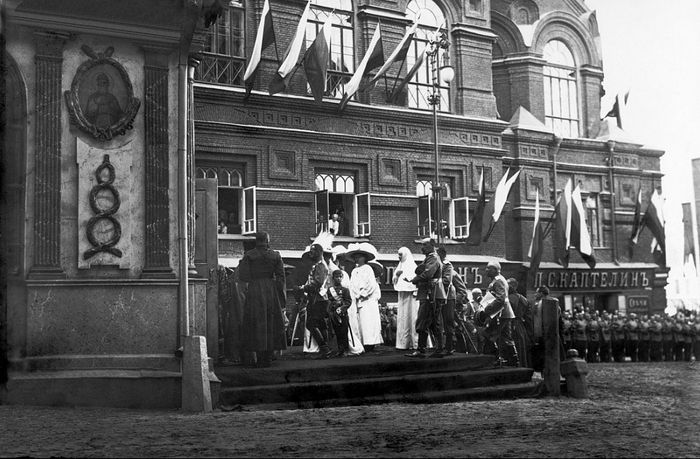 Tsesarevich Aleksei with his family arriving at the Iverskaya Chapel at the Kremlin in May 1912. © Liki Rossii, 2016
Tsesarevich Aleksei with his family arriving at the Iverskaya Chapel at the Kremlin in May 1912. © Liki Rossii, 2016 Digging deeper, Christie’s Russian Art specialists looked for more information on Tsesarevitch Aleksei’s first official visit to Moscow. Eventually, they came across the memoirs of Vladimir Dzhunkovsky (1865–1938), the Governor-General of Moscow in May 1912, which describe the Imperial state visit in detail.
According to his account, just days before the statue of Alexander III was unveiled, Emperor Nicholas I and his family received an official delegation of statesmen, nobility and city representatives in the Dormition Cathedral in the Kremlin. During this reception, Nikolay Guchkov, the Mayor of Moscow, presented an icon of St. Alexis to Tsesarevich Aleksei on behalf of the Moscow City Council, proclaiming, ‘God bless you and may the Great Bishop of Moscow Alexis guide you to the delight of your parents and for the benefit of the Russian people’.
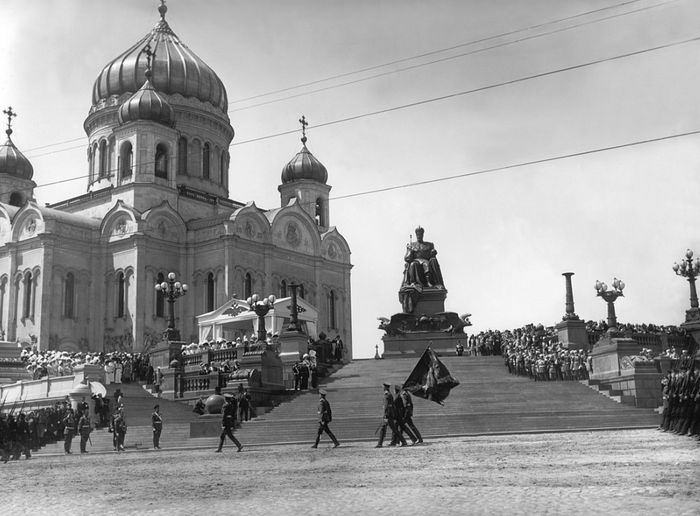 Emperor Nicholas II and his family during the opening ceremony of the monument to Alexander III, 30 May 1912. © Liki Rossii, 2016
Emperor Nicholas II and his family during the opening ceremony of the monument to Alexander III, 30 May 1912. © Liki Rossii, 2016 It suddenly became clear that the phrase ‘City of Moscow’ in the icon’s inscription referred not to the location of its presentation, but to its presenter. The memoirs of the contemporary witness were crucial in establishing this connection. ‘What also suddenly made perfect sense is the depiction of two other saints on either side of St Alexis: St. Peter and St. Jonah, who were patron saints of the City of Moscow,’ Oganesian adds.
As most Russian Imperial objects were either destroyed or sold by the Bolsheviks after the 1917 revolution, this beautiful icon, never before seen on the market, ‘is a wonderful and rare survivor’, Oganesian says.

